|
| |
|
* Sthiti:
Sit with legs stretched, heels pressing on the ground by the side of
buttocks, to keep the body at right angles to the legs with an erect
spine.
* Sthiti is
same for all Sitting Postures 7 to 16.
|
-
Bend the legs backwards
to come to Vajrasana position. Kneel down on the floor, keeping
the knees apart. Keeping the elbow joints close to each other,
place the palms on the ground in between the knees, fingers
pointing inwards towards the feet.
-
Bend at the elbow
joints, support the body at the 'Nadhi' (navel) and place the head
down touching the ground.
-
Stretch the feet back,
toes on the ground.
*Return to
Sthiti. | |
 |
|
BENEFITS: Makes
the wrists flexible and the arms stronger. Improves digestion. Helps to
clear constipation. Activates the
pancreas.
|
|
Mayurasana (Peacock
posture) |
-
Bend the legs backwards to
come to Vajrasana position. Kneel down on the floor, keeping the knees
apart. Keeping the elbow joints close to each other, place the palms on
the ground in between the knees, fingers pointing inwards towards the
feet.
-
Bend at the elbow joints,
support the body at the 'Nadhi' (navel) and place the head down touching
the ground.
-
Stretch the feet back, toes on
the ground.
-
Keeping elbow joints as
fulcrum, move forward to raise and balance the body parallel to the
ground. Look forward, Fore0arms are slightly inclined to the front.
Return to Sthiti. |
 |
|
BENEFITS:
Beneficial for all stomach disorders. Tones up abdomen, strengthens the
forearms, wrists and elbows. Prevents accumulation of gas. Vitalizes the
endocrine in the abdomen. |
|
Vajrasana (The Ankle
posture) |
|
*Start from Sthiti
|
-
Slowly bend the right leg, and keep the heel tight under
the buttock.
-
Bring the left leg under
the left buttock. Keep the knees close to each to each other,
spine erect, the head, shoulders and buttocks in a vertical line.
Rest the palms on the upper part of the thighs or covering the
knees. Close the eyes and meditate.
*Return to
Sthiti.
|
|
BENEFITS:
A meditative posture as we can sit comfortable for a long time with
erect spine. Useful in cases of varicose veins; mobilizes stiff
ankles and knees. | |
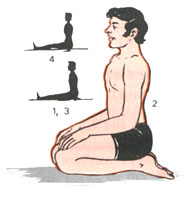 |
|
Supta-Vajrasana (The Supine Vajrasana)
|
-
Slowly bend the right leg, and
keep the heel tight under the buttock.
-
Bring the left leg under the
left buttock. Keep the knees close to each to each other, spine erect,
the head, shoulders and buttocks in a vertical line. Rest the palms on
the upper part of the thighs or covering the knees. Close the eyes and
meditate.
-
Recline slowly backwards
taking the body weight on the right elbow first and then the
left.
-
Lie flat on the back. Keep the
hands crossed above the head. Keep the knees close together, touching
the ground.
*Return to Sthiti. |
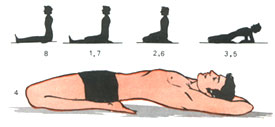 |
|
BENEFITS:
Activates and tones up the large group of nerves which arise in the lower
lumbar region and pass through the buttocks down the back of the thighs.
Good for mobilizing hips, ankles and lower
back. |
|
Sasankasana (Moon
Posture) |
-
Slowly bend the right leg, and
keep the heel tight under the buttock.
-
Bring the left leg under the
left buttock. Keep the knees close to each to each other, spine erect,
the head, shoulders and buttocks in a vertical line. Rest the palms on
the upper part of the thighs or covering the knees. Close the eyes and
meditate.
-
Catch the right hand with the
left behind the back.
Bend forwards from the waist;
rest the forehead on the ground in front of the knees.
*Come up through 5 to 8. |
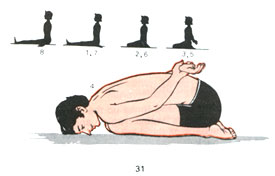 |
|
BENEFITS: This
vitalizes the organs in the abdomen and pelvis and tones up the nervous
system especially the lumbosacral nerves. Help in cases of seminal
weakness. This can be performed more easily than Yogamudra (5, 3, 4) with
the same benefits. |
|
Pascimatanasana (Posterior
stretching) |
|
*Sthiti;
-
Raise both hands till they
come to a straight line parallel to the ground.
-
Raise the hands to vertical
position, arms touching the ears, palms facing front. Stretch up the
whole body from Coccyx. Inhale.
-
Bend the trunk forward
relaxing with continuos exhalation. Body and hand parallel to the
ground. |
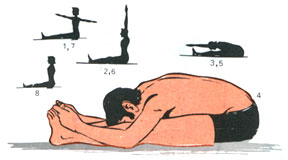 |
- From hooks of the
index fingers and catch hold of the big toes. Bend the back further
forward from the lumbosacral region so that the trunk is stretched along
the thighs and face rests on the knees. Bend the hands at the elbows and
relax the abdominal muscles. Do not allow the knees to bend. Maintain
for about 2 minutes. Normal breathing. Slowly raise the trunk with
inhalation.
*Come back to Sthiti through 5 to
8.
BENEFITS:
Pascimatanasana stimulates the nerves of the spinal column through
extreme flexion of spine. Stimulates the gastric fire. Fat in the
abdomen is reduced. Other abdominal organs like liver, pancreas and
intestines are also rendered active. Helps to remove constipation.
It can be made use of for rousing spiritual forces, normally lying
dormant at the base of the spine. |
|
Ustrasana (Camel
posture) |
|
*Come to Sthiti
position |
-
Bend right leg backward.
-
Bend the left leg to come to Vajrasana.
-
Raise up making the trunk vertical.
-
Inhale and bend the body
backwards and being the hands on the heels.
*Exhale while coming back to Sthiti through 5 to
8. | |
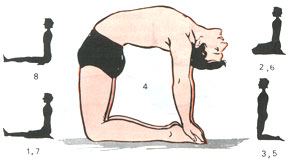 |
|
BENEFITS: Makes the spine
flexible. Increases blood-flow to the brain. Good for back problems.
|
|
Padmasana (Lotus
posture) |
|
This is
the famous meditative posture. The erect spine and the symmetrical posture
help in bringing stability to mind. |
|
*Start with Sthiti.
- Bend the right led
in the knee-joint, folding it upon itself, place the foot at the left
groin. In the same way, place the left foot at the right groin; both
soles are turned upwards. Heels almost meeting in front of the pelvic
bones.
- Sit erect. Hands on
the thighs with bent elbows. Meditate for a while and return to
Sthiti.
|
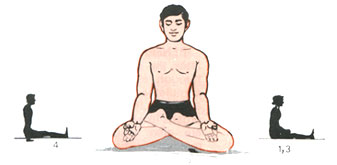 |
|
BENEFITS: This
meditative posture is the most popular one. Keeps the awareness, makes a
comfortable posture so that one can sit for a long time. Reduces the fat
around the thighs. |
|
Vakrasana (Twist
posture) |
|
*Start with Sthiti.
-
Bend the right leg at the
knees and place it by the side of the left knee of the extended
leg.
-
Straighten and twist the waist
towards the right side and take the left hand round the right knee and
catch hold of the right big toe. Take the right hand behind, keep the
palm on the ground in such a way that the trunk is kept erect, with a
proper twist. Breathe normally. After maintaining for about a minute
return to Sthiti through 3.
*Repeat the same on the other
side.
|
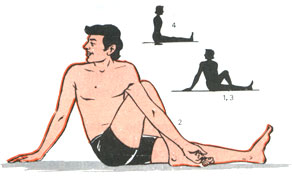 |
|
BENEFITS:
Lateral twist obtained in this asana has the same benefits as Ardha
Matsyendrasana (3,3,16) |
|
Ardha Matsyendrasana (The Half-Twist
posture) |
|
*Start with
Sthiti.
*This is named after a great Yogi,
Matsyendra.
- Bend the right leg
at the knee and place the heel tight against the perineum.
- Keep the foot of the
left leg by the side of the right thigh near the knee.
- Bring the right hand
round the outer side of the left knee passing between the chest and the
knee and catch hold of the left big toe. The right shoulder blade rests
on the outer side of the left knee.
|
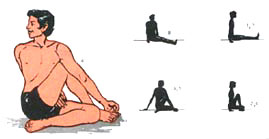 |
- Now take the left
hand round the back and try to catch the right thigh. Look back over the
left shoulder, (The erect knee acts as a fulcrum for getting maximum
twist of the spine). Keep the trunk vertical. Do not sit on the heels.
Maintain for sometimes.
*Come back to Sthiti through 5 to
8.
*Repeat the same, on the other
side.
BENEFITS: This lateral twist makes the spine
elastic. All the spinal nerves are toned up. Helps to cure constipation
and dyspepsia. A useful posture for diabetes and kidney troubles.
Abdominal girth is reduced. |
Disclaimer and terms of use
Copyright © Shanith Babu Nagarajan. All rights reserved.
|